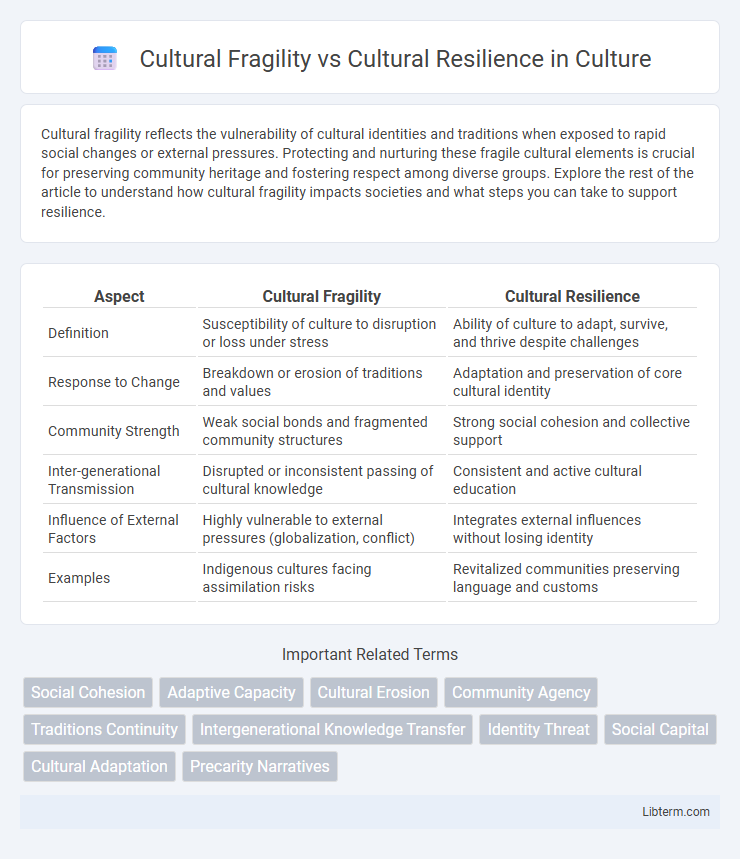Cultural fragility reflects the vulnerability of cultural identities and traditions when exposed to rapid social changes or external pressures. Protecting and nurturing these fragile cultural elements is crucial for preserving community heritage and fostering respect among diverse groups. Explore the rest of the article to understand how cultural fragility impacts societies and what steps you can take to support resilience.
Table of Comparison
| Aspect | Cultural Fragility | Cultural Resilience |
|---|---|---|
| Definition | Susceptibility of culture to disruption or loss under stress | Ability of culture to adapt, survive, and thrive despite challenges |
| Response to Change | Breakdown or erosion of traditions and values | Adaptation and preservation of core cultural identity |
| Community Strength | Weak social bonds and fragmented community structures | Strong social cohesion and collective support |
| Inter-generational Transmission | Disrupted or inconsistent passing of cultural knowledge | Consistent and active cultural education |
| Influence of External Factors | Highly vulnerable to external pressures (globalization, conflict) | Integrates external influences without losing identity |
| Examples | Indigenous cultures facing assimilation risks | Revitalized communities preserving language and customs |
Understanding Cultural Fragility: Definitions and Indicators
Cultural fragility refers to the vulnerability of cultural identities and practices to external pressures such as globalization, colonization, or social marginalization, often manifesting through loss of language, traditions, and communal cohesion. Indicators of cultural fragility include diminishing intergenerational knowledge transmission, weakened social networks, and increased assimilation into dominant cultures. Understanding these signs is crucial for implementing preservation strategies that bolster cultural resilience and maintain the integrity of diverse cultural heritages.
Defining Cultural Resilience: Core Characteristics
Cultural resilience refers to a community's ability to maintain and adapt its cultural identity, traditions, and values in the face of external pressures or disruptions. Core characteristics include adaptability, strong social networks, intergenerational knowledge transfer, and a deep connection to place and history. These elements enable cultures to recover from trauma, sustain their practices, and thrive despite challenges.
Historical Roots of Cultural Fragility
Cultural fragility often stems from historical events such as colonization, forced assimilation, and systemic marginalization, which disrupted traditional practices and weakened community structures. These traumatic experiences caused loss of language, identity, and heritage, making cultures more vulnerable to external pressures and internal conflicts. Understanding these historical roots is essential for addressing cultural fragility and fostering cultural resilience through revitalization efforts and community empowerment.
Factors That Strengthen Cultural Resilience
Strong social networks, inclusive community practices, and preservation of traditional knowledge are key factors that strengthen cultural resilience. Active participation in cultural rituals, adaptive responses to socio-economic changes, and intergenerational transmission of language and customs reinforce a community's cultural identity. Access to education and supportive policies also enhance the capacity of cultures to withstand external pressures and recover from disruptions.
The Impact of Globalization on Cultural Stability
Globalization accelerates cultural exchange and integration, often challenging cultural stability by introducing external influences that may erode traditional practices and values. Cultural fragility emerges when communities struggle to maintain identity amid rapid social and economic changes, leading to the loss of languages, rituals, and customs. Conversely, cultural resilience enables societies to adapt and incorporate global elements while preserving core cultural traits, fostering continuity and innovation within cultural frameworks.
Case Studies: Fragile vs Resilient Communities
Fragile communities such as the Flint water crisis in Michigan illustrate cultural fragility through the erosion of trust and systemic neglect that undermine social cohesion. In contrast, the Maori communities in New Zealand demonstrate cultural resilience by actively revitalizing language and traditions, strengthening identity despite historical marginalization. These case studies highlight how adaptive practices, community leadership, and resource access determine the capacity to withstand cultural disruptions.
Social Media’s Role in Shaping Cultural Narratives
Social media platforms amplify cultural fragility by rapidly spreading misinformation and fostering polarized narratives that can undermine community cohesion. Conversely, they also promote cultural resilience by enabling marginalized voices to share authentic stories and preserve heritage through digital archives and global connectivity. The dynamic interplay between these forces highlights social media's significant impact on shaping and redefining cultural identities in the digital age.
Education’s Influence on Cultural Continuity
Education plays a pivotal role in fostering cultural resilience by integrating indigenous knowledge and values into curricula, thereby promoting cultural continuity across generations. Cultural fragility often emerges when educational systems marginalize native languages and traditions, leading to erosion of identity and community cohesion. Strengthening culturally responsive pedagogy ensures that learners develop a strong sense of heritage while adapting to modern societal demands.
Strategies for Fostering Cultural Resilience
Implementing community-led initiatives that prioritize indigenous knowledge and traditions strengthens cultural resilience by reinforcing identity and social cohesion. Education programs that incorporate multilingual curricula and culturally relevant content promote intergenerational transmission of values and skills. Support for local arts, rituals, and ceremonies serves as a vital strategy to preserve heritage while adapting to social changes, countering the effects of cultural fragility.
The Future of Cultures: Fragility or Resilience?
Cultural fragility highlights the vulnerability of traditions and identities to globalization, environmental changes, and sociopolitical pressures, threatening their continuity and distinctiveness. In contrast, cultural resilience emphasizes adaptive capacities, innovation, and community engagement that enable cultures to thrive amidst challenges by preserving core values while embracing change. The future of cultures hinges on fostering resilience through education, intercultural dialogue, and policy support to safeguard cultural diversity and promote sustainable cultural ecosystems globally.
Cultural Fragility Infographic

 libterm.com
libterm.com